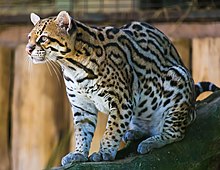Ocelots
| Ocelot | |
|---|---|
 |
|
| Scientific classification | |
| Kingdom: | Animalia |
| Phylum: | Chordata |
| Class: | Mammalia |
| Order: | Carnivora |
| Family: | Felidae |
| Genus: | Leopardus |
| Species: | L. pardalis |
| Binomial name | |
|
Leopardus pardalis (Linnaeus, 1758) |
|
| Subspecies | |
|
See text |
|
 |
|
| Range of the ocelot | |
| Synonyms | |
|
Felis buffoni Brass, 1911 |
|
See text
Felis buffoni Brass, 1911
F. chati Gray, 1827
F. hamiltonii J. B. Fischer, 1829
F. mexicana Kerr, 1792
F. pardalis Linnaeus, 1758
Leopardus griseus Gray, 1842
The ocelot (Leopardus pardalis; /ˈɒsəlɒt/), also known as the dwarf leopard, is a wild cat distributed extensively within South America, including the islands of Trinidad and Margarita, Central America, and Mexico. North of Mexico, it is found regularly only in the extreme southern part of Texas, although there are rare sightings in southern Arizona.
Its fur was once regarded as particularly valuable. As a result, hundreds of thousands of ocelots were killed for their fur. The cat was listed as a Vulnerable from 1972 until 1996 and is now listed as Least Concern on the IUCN Red List.
The ocelot is a member of the genus Leopardus and is classified under the family Felidae. The ocelot was first described by Swedish zoologist Carl Linnaeus in the 10th edition of Systema Naturae (1758) as Felis pardalis, placing it in the genus Felis along with the domestic cat, Eurasian lynx, jaguar, leopard, lion and tiger. The name ocelot comes from the Nahuatl word ōcēlōtl (pronounced [oːˈseːloːt͡ɬ]), which usually refers to the jaguar (Panthera onca) rather than the ocelot. Another possible origin for the name is the Latin cellatus ("having little eyes" or "marked with eye like spots"), in reference to the cat's spotted coat. Other names for the ocelot include cunaguaro, manigordo, mathuntori, ocelote, onsa, pumillo, tigri-kati and tigrillo.
...
Wikipedia

